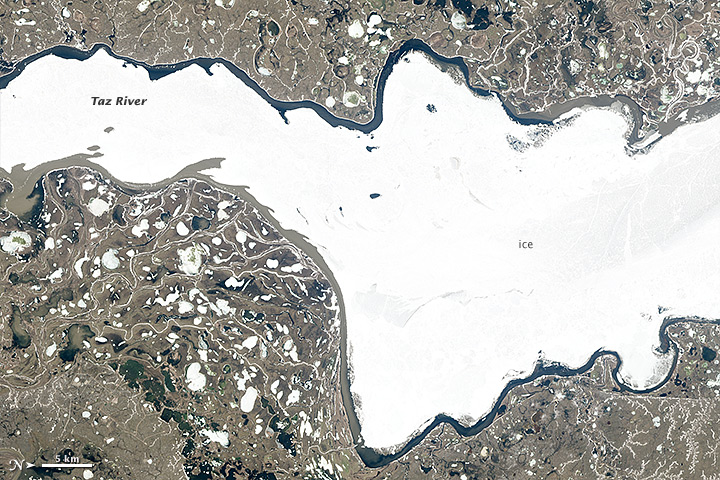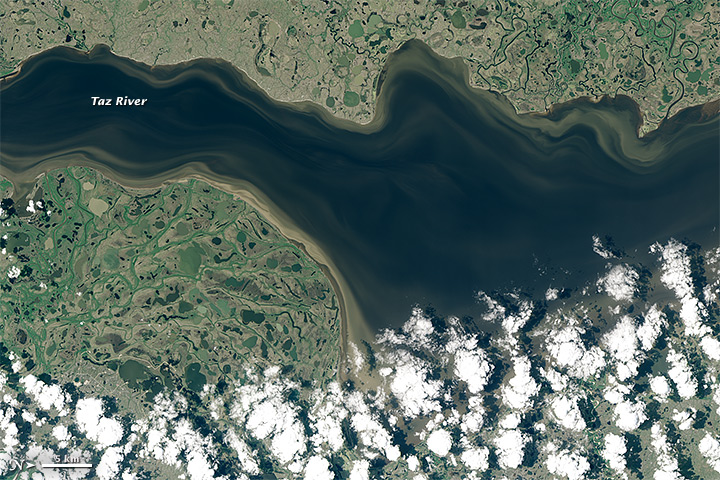NASA: Russia - Taz River - 25.07.13
Posted by Ricardo Marcenaro | Posted in NASA: Russia - Taz River - 25.07.13 | Posted on 22:01

acquired June 9, 2013
download large image (5 MB, JPEG, 6000x6000)
acquired June 9, 2013
download GeoTIFF file (72 MB, TIFF)

acquired June 18, 2013
download large image (5 MB, JPEG, 6000x6000)
acquired June 18, 2013
download GeoTIFF file (71 MB, TIFF)

acquired July 4, 2013
download large image (4 MB, JPEG, 6000x6000)
acquired July 4, 2013
download GeoTIFF file (66 MB, TIFF)
acquired June 9 - July 4, 2013
download Google Earth file (KML)
Editor’s Note: Today’s caption is the answer to Earth Observatory’s July Puzzler.
Change is often elusive to see, visible only in the contrast between before and after. But on June 18, 2013, the Operational Land Imager on the Landsat 8
satellite captured Russia’s Taz River in transition (middle image). Ice
was breaking up on the river, while sediment-laden spring floods piled
up behind the unmoving mass. The wetlands and tributaries surrounding
the river were similarly suspended in a half-frozen, half-thawed state.
The area had been frozen a little more than a week earlier (June 9),
when Landsat 8 acquired the top image, and was entirely ice free just
over two weeks later (July 4), when the lower image was acquired.
The Taz River is one of many that drain into the Arctic Ocean and its
surrounding seas. But as Arctic rivers go, the Taz is relatively minor.
About 33 cubic kilometers of water flow from the river into the Kara Sea every year. The Taz’s strongest flow
usually occurs in June. By contrast, the largest contributor to the
Arctic Ocean, the neighboring Yenisey River, discharges 580 cubic
kilometers annually.
The spring thaw sends an annual gush of fresh water into the Arctic
Ocean, which is the most dominated by fresh water of all the world’s
oceans. This fresh outflow plays a role in sustaining Arctic sea ice.
Because it is less dense than salty water, the fresh water sits near the
surface and forms a layer that insulates sea ice from deeper, warmer
seawater. Contact with the warmer water would cause the sea ice to melt
at a faster rate.
Too much fresh water, however, has the potential to interfere with ocean currents; some researchers suspect it could slow the global ocean conveyor belt.
For these reasons, scientists are keen to track the output of Arctic
rivers. In recent years, scientists noted that Arctic waters near Canada
have been growing fresher. A 2012 Nature paper
tracked the source of the fresh water to Russia’s great Arctic rivers.
Weather patterns had moved the water from the Asian side of the Arctic
to the North American side, though overall Arctic Ocean salinity
remained unchanged.
References
- Arctic Great Rivers Observatory. Accessed July 19, 2013.
- ArcticRIMS. List of ArcticRIMS discharge stations and Stream discharge station data: Taz at Sidorovsk. Accessed July 19, 2013.
- Morison, J. et al. (2012, January 5) Changing Arctic Ocean freshwater pathways. Nature, 481: 66. Accessed July 19, 2013.
- University of Washington (2012, January 4) Russian river water unexpected culprit behind Arctic freshening, researchers find. ScienceDaily. Accessed July 19, 2013.
NASA Earth Observatory images by Jesse Allen and Robert Simmon, using Landsat data from the U.S. Geological Survey. Caption by Holli Riebeek. Congratulations to Sean for being the first person to solve the puzzle. GeologyDave gets credit for providing exact coordinates a few minutes later.
- Instrument:
- Landsat 8 - OLI
NASA: Russia - Taz River - 25.07.13
Ricardo M Marcenaro - Facebook
Blogs of The Solitary Dog:
Solitary Dog Sculptor:
http://byricardomarcenaro.blogspot.com
Solitary Dog Sculptor I:
http://byricardomarcenaroi.blogspot.com
Para:
comunicarse conmigo,
enviar materiales para publicar,
propuestas comerciales:
marcenaroescultor@gmail.com
For:
contact me,
submit materials for publication,
commercial proposals:
marcenaroescultor@gmail.com
Diario La Nación
Argentina
Cuenta Comentarista en el Foro:
Capiscum
My blogs are an open house to all cultures, religions and countries. Be a follower if you like it, with this action you are building a new culture of tolerance, open mind and heart for peace, love and human respect.
Thanks :)
Mis blogs son una casa abierta a todas las culturas, religiones y países. Se un seguidor si quieres, con esta acción usted está construyendo una nueva cultura de la tolerancia, la mente y el corazón abiertos para la paz, el amor y el respeto humano.
Gracias :)


Comments (0)
Publicar un comentario